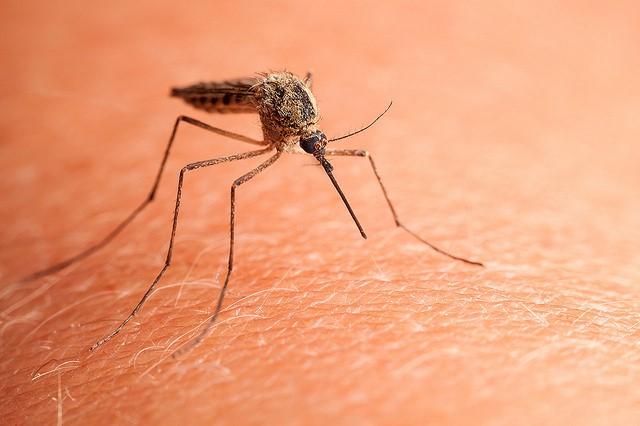
Climate change is making the Pacific Northwest the perfect breeding grounds for mosquitoes and so far, it’s created the largest outbreak in more than a decade in Multnomah County.
After the wettest spring in 81 years followed by warm summer temperatures, Multnomah County is seeing tens of thousands more mosquitoes – the most since 2010.
A Multnomah County public health team has been surveying the county — usually near the Columbia River — for breeding habitats and monitoring for mosquito-borne diseases. The team sets mosquito traps in 150 different locations.
Bek Sudia, the team leader, said rain earlier this year caused low-level river flooding that created breeding grounds for mosquitos. Last year, she said her team trapped about 6,000 mosquitos, with each trap catching an average of 100.
This year that number has increased eightfold.
“This year at some sites we are catching upward of 15,000 in a single trap,” she said. “We are edging towards 40,000 and we’re only about a third of the way through the season.”
Right now, Sudia said Sauvie Island is experiencing the highest number of mosquitoes and it doesn’t take much for them to thrive. They prefer temperatures between 60 to 100 degrees Fahrenheit and are very active from June through August.
“They love the cool evenings when it gets around 70, it’s like their perfect time which is why if you’re sitting out at dusk they will come to feast,” she said.
Mosquitoes can lay up to 300 eggs at a time and those eggs transform into a flying mosquitoes in seven to 10 days. Sudia said mosquitoes also hatch more quickly in the heat.
‘Expect more mosquitoes’
As the burning of fossil fuels continues and the climate gets warmer, the region will start to experience wetter springs and hotter and drier summers. That means more water in natural areas and low-level flooding along rivers — perfect for mosquitos.
“One of our concerns as our climate shifts, we could see different types of mosquito populations moving northward because our climate becomes more favorable and those species are the ones that carry the viruses that you hear about like Zika and dengue, we do not yet have those,” she said. “But as our climate shifts, there is a very high possibility that we could have those in the future.”
So far no batch of mosquitoes have tested positive for West Nile virus in Multnomah. According to the Centers for Disease Control and Prevention, West Nile virus is commonly spread to people by the bite of an infected mosquito. Most people who get infected develop no symptoms. But those who do, develop Febrile illness, or a fever, with other symptoms like body aches, headache, and vomiting. Most severe cases affect the central nervous system and most people who develop this severe illness die. There is no vaccine or specific medications for West Nile virus.
The Environmental Protection Agency said climate change is expected to affect the geographical and seasonal patterns of vector-borne illness in the United States. From 1999-2019, more than 51,000 cases of West Nile virus were reported, with nearly half of those people experiencing severe illness that caused neurologic dysfunction.
Salah Uddin Khan, a researcher at the National Microbiology Laboratory of the Public Health Agency of Canada, looked at what climate drivers make it ideal for mosquitoes to be in one region. His team examined what would happen with the continued burning of fossil fuels and extreme conditions in the United States and Canada. In the Pacific Northwest, his team saw an increased probability for warmer conditions that attract the Yellow Fever mosquito and Forest day mosquito.
“They are somewhat different from what we see, they are very invasive mosquitoes,” he said. “Globally, these species have been responsible of spreading dengue and chikungunya pathogens.”
Khan said his team also saw evidence that the Pacific Northwest would become a more suitable breeding ground for mosquitoes through 2050.
“Expect more mosquitoes of these particular two species during summer,” he said. “At the same time, there needs to be an enhanced mosquito surveillance going on to see what is in those mosquitoes.”
Just because mosquito populations increase doesn’t mean they all bring viruses and disease, he said. But these types of mosquitoes’ biting habits are more aggressive and will bite more in the mornings or in the evenings.
The Multnomah County team does not lay traps in residential areas but the public can help reduce and kill populations by removing standing water. Residents can also get mosquitofish to control mosquito larvae in ponds. Another option is using a chemical-infused fog to treat areas. Extreme heat of 100 degrees or more and wildfire smoke also kill populations.
Sudia said the smaller sneaky mosquitoes are called flood-water or nuisance mosquitoes and those are the ones coming from the recent flooding along the Columbia River. She said those do not carry any virus but the larger ones do.
“We haven’t had West Nile in Multnomah County since 2007,” she said. “However, it is in eastern and southern Oregon almost every year. So, there is always a possibility that we could have West Nile in Multnomah County. It’s been a long time but we have the mosquitoes, we definitely have the numbers this year.”
Clark County’s Mosquito Control District has also seen an increase in mosquitoes and has been working to reduce populations since April. The county has never had a positive West Nile test result, though the virus has been detected in mosquitoes in other parts of the state.
Officials said their team recently used a helicopter to treat more than 1,600 acres of mosquito breeding grounds with larvicide and is working to address more than 300 requests for service submitted over the last three weeks.
This story was originally published by Oregon Public Broadcasting.
